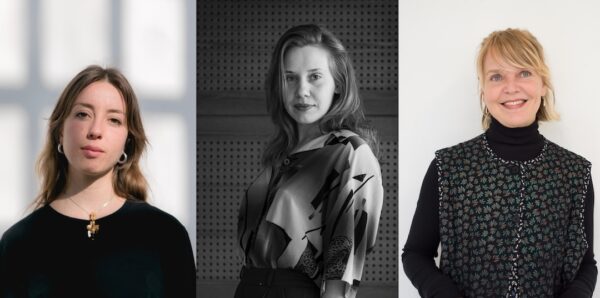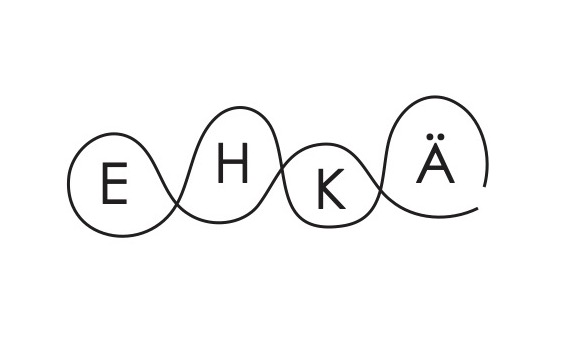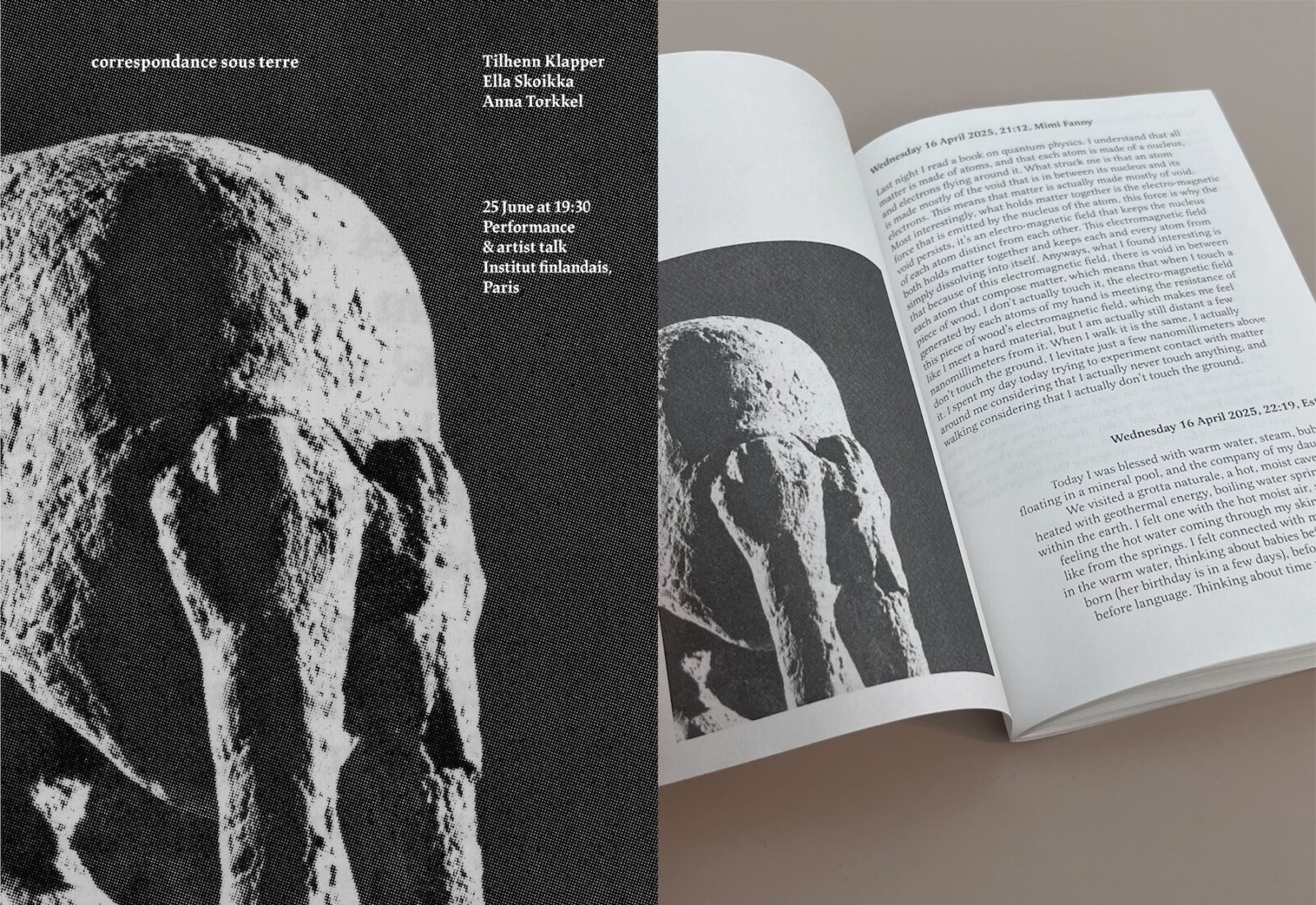Institut finlandais and Ehkä Production invited French artist Tilhenn Klapper and Finnish artists Anna Torkkel and Ella Skoikka to participate in a creative correspondence during 8 weeks in the spring of 2025, when nature started to bloom and sprout. The project was facilitated and conceptualized by artist Saija Kangasniemi, who worked as a producer at Institut finlandais at the time.
Through a collective diary practice, the artists shared their inner landscapes through intuitive daily writings about ordinary and extraordinary life and the things that are often invisible, as well as their artistic practices in the form of dance and sound. French artist Lia Pradal (editions Païen) designed the printed diary booklet and created the visuals for the project.
Could inner landscapes dissolve into a collective experience and create moments of interdependence? What kind of connections could be created through artistic-spiritual practices between two countries, through a correspondence that travels under the earth? What kind of energy, questions and ideas could be transmitted underground and what kind of topics rise to the surface?
We met with the artists to learn more about the project.
What kind of topics are you discussing in the correspondence? What kind of guidelines did you have for writing the diary?
Anna: The topics of the correspondence were not decided beforehand. The concept of sharing artistic-spiritual research practices set the framework for writing. The idea of the correspondence was to keep a daily notebook for ourselves and others, to keep us connected to the questions of the project in the form of a shared, transforming online diary. The writings ranged from artistic questions to everyday personal matters. We shared many experiential observations related to nature and spring. We tackled themes such as death, growth, embodiment, emotions and the interconnection of these matters recurs throughout the diary. I love our shared diary! I think the freedom of the format is the core of it all – you could share either a long text or maybe just one word. Your note of the day could also be a photo or a link.
Tilhenn: I wrote down things I wanted to share: feelings, images, experiences, comments, observations that I felt were valuable. We eventually got to the understanding that we would simply share what counts, that is, what we care to share. Yet, without prior decisions, we circled together around death, grief, dreams, memories, and moments of awe at the gaze of nonhuman life forms.
Ella: We also touched on themes such as movement, strange occurrences, connection, interdependence, longing, family, conflict, contradiction, beauty and questions around what is spirituality. These themes formed a kind of web and as we were allowed to jump back in time to make commentary entries, it kept growing in many directions. What we wrote changed in time and in relation to later writings.
Tilhenn: The diary was like a companion with whom I experienced April and May. It fostered a different attention to things, like how my day unfolded and how I would look back on it. It enabled me to share thoughts and feelings that I had during the day or night that struck me and that would have eventually disappeared if not for the diary. Also, since we chose to keep the diary interactive with the possibility to comment or react to someone else’s words, many thoughts I wrote down were feelings or memories I had when reading someone else’s writing. This was a very important part of the experience for me and probably the space where it got the most intimate and deep.
Ella: The guidelines for the whole project were soft, open and slightly mysterious in a beautiful way. I felt the diary was such an open embrace for many things to come to the surface. It also felt like a safe haven; there was a sense of trust that what’s written is taken with warmth.
The starting point of the project was to create a platform for international artistic dialogue and to create meaningful and deep connections, outside of the strategies of success, performance and efficiency. What kind of connections have you found through your diary-writing practice?
Anna: Saija’s proposal to create connection as a starting point and aim of the project, felt important and beautiful to me. The concept felt like a slowing down, a rooting, and a kind of positive resistance in the midst of all the striving for efficiency and success that surrounds us. It’s been fascinating to notice how a sense of connection can emerge through shared practice with previously unknown people. The collective medium of writing has inspired imagination, born from real-life events of the other group members. I’ve been thinking a lot about the relationship between imagination and reality, their connection, and how important imagination is in life. It’s been inspiring to drift within the connections between things, people, content, and thoughts, and let new threads of connection develop and grow.
Saija: The project is part of the pARTir initiative, funded by the European Union, that supports responsible and sustainable internationalization of art. Through the project we wanted to propose a radical and experimental alternative to international networking and artist mobility. For us, this network encompasses the connections to everything in the living Earth and all the invisible things.
Ella: The diary followed and accompanied me during the spring and the process of writing it together was such a special way to get to know people. Perhaps in the end I got to know them better than many others.

Why did this correspondence have to be done underground? Is there something you would like to share about the idea of undergroundness?
Saija: We wanted to create a platform, where we could freely express things based on our intuition. I guess many of us are quite used to the academic setting, where things need to be referenced and justified and a lot of research is done. In the beginning we agreed that the things we write can be as random, intuitive, academic, intellectual as each of us want. We also wanted to emphasize the connection to the Earth itself as a starting point for reflecting on what is meaningful or what is spiritual to each of us. Going under the earth where it’s dark, where no one can see you feels somehow comforting and like a safe space where there is no judgement. How a personal diary might feel for many. In nature, the underground is also a place where countless connections, sharing and maybe even caring happens.
Ella: When I think of the earth and the underground I think about processes and cycles. How things sprout, grow, die and decay, decompose. Nourishing growth again. I think of old mythologies as well. The idea of other realities surrounding us that we cannot see. Above us, underneath us, there are other worlds. It’s not only about mythologies but also about how we perceive, and don’t perceive a lot of what happens underground, or between us.
How does it feel to publish these intimate and personal writings?
Anna: Publishing the correspondence naturally feels like a significant step. At the core of the project has been the idea of undergroundness, which has provided a sense of safety and calm for our shared process. Bringing the texts to the public eye feels like revealing a secret. At times, the texts have been very personal and intimate, and as the process unfolded, we ended up sharing rather sensitive matters with each other. We had a joint discussion about publishing and decided that the diary would be shared with the public only in printed form, in a limited edition. This feels like the right decision – it would be strange if the texts were permanently available online for everyone to read!
Tilhenn: The diary unexpectedly became very intimate (I say unexpectedly because we didn’t know each other beforehand). Sharing the content of this diary was the first question we asked ourselves. Can and should this be shared? The printed format seemed the only possible option, online was really too open with too wide a diffusion for such fragile and intimate content. It is also important for me that not too many editions were printed and that they are only given away during the performance at Institut finlandais.
You collaborated with the French artist Lia Pradal, who runs her own small edition house Païen. She designed the printed diary booklet with your writings and created the visuals for the project. Can you tell us something about the collaboration? What did your collaboration add to the project?
Saija: Lia lives in the mountains, and as we didn’t have the chance to meet her in person, we started a sort of correspondence with her as well to create the visuals of the project. In the beginning we let her read all our writings, and she was moved and inspired by them. It was a beautiful way to start our collaboration.
Ella: It was interesting to have our texts read by an outsider (non-writer of the diary) and to see what kind of visualisation and layout this sharing would inspire. I feel Lia captured the spirit of the writings together, the texts and pictures in conversation with each other in the outcome.
You are all coming to Paris together to create a performance at Institut finlandais based on the diary writings and the artistic practices shared over the past two months. How does that feel? Could you tell us something about the performance?
Anna: I think it’s wonderful that the project is also taking shape as a performance, and that we are all meeting in person. We will continue the writing practice until the night of the performance. In a way, the performance becomes part of the diary. The evening will take its form through fragments of text, singing, dancing and sound. We will create things together, individually, and perhaps a little bit with the audience.
How does it feel now when the project is coming to an end? Are you going to keep writing a diary individually or collectively?
Tilhenn: I am very grateful for this project. Nowadays, it doesn’t happen so much in the arts that emotions and thoughts take such a collective path, or at least that they become and take shape, by traveling through different minds and mouths. The concept was quite simple. It was a matter of taking the time to share. Even just a tiny bit of time, wherever we are in the world, whatever we are busy with. And we did it together; we played that game and something happened.
The project Correspondance sous terre is supported by Institut finlandais within the framework of the pARTir initiative, funded by the European Union – NextGenerationEU.



